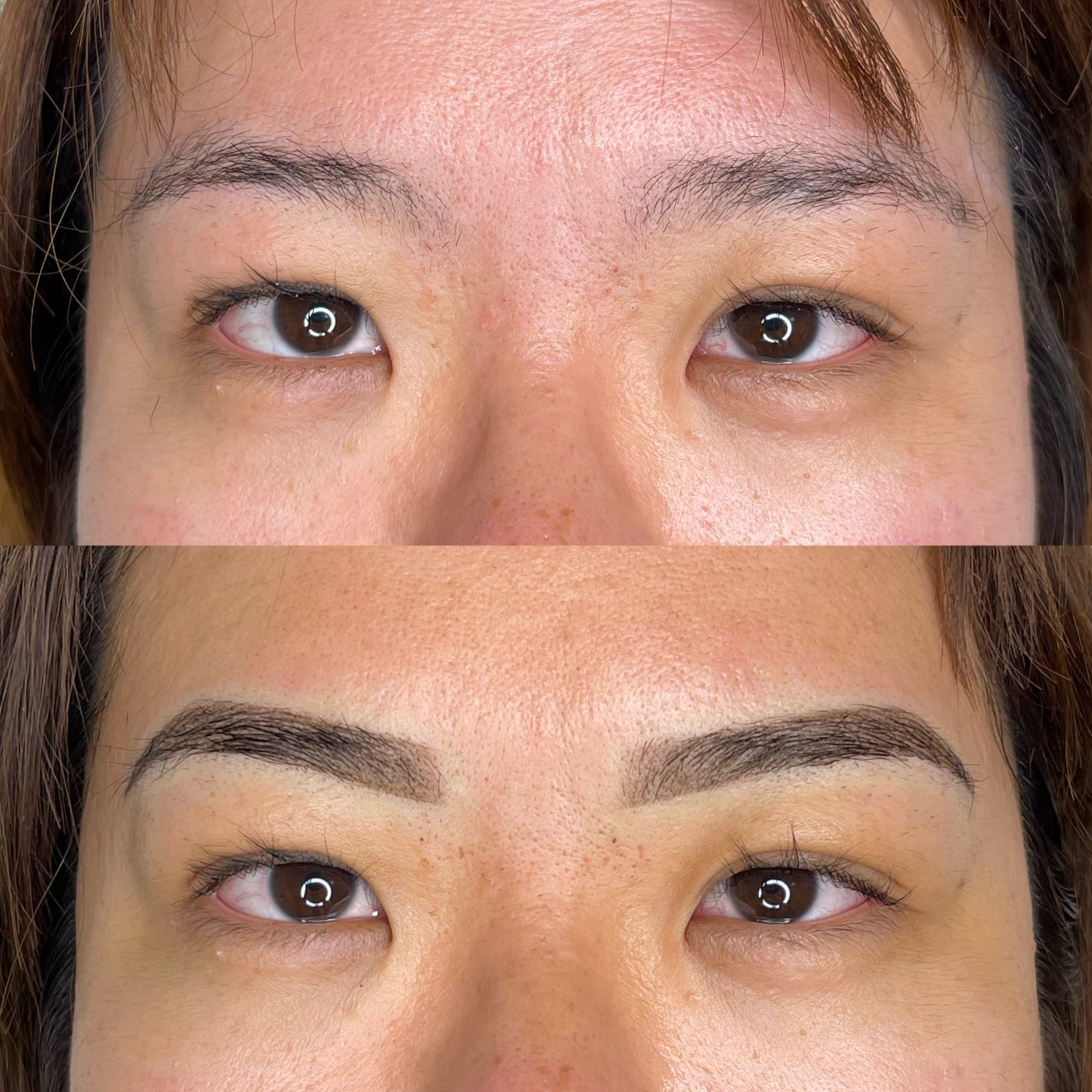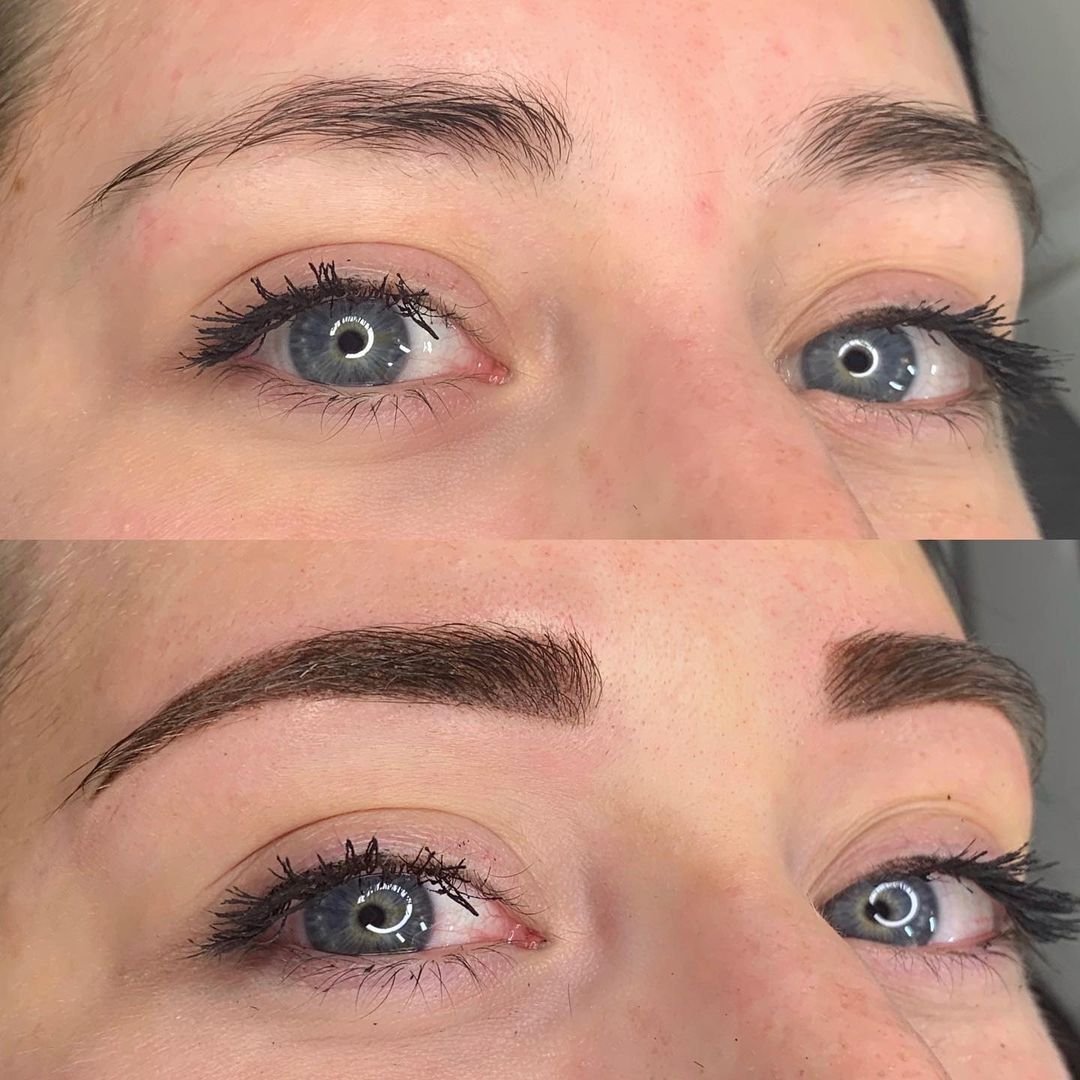Cosmetic tattoo is a solution for women and men who have thin, sparse, or asymmetrical brows, temporary or permanent hair loss, or a desire for a simplified daily routine. Whether you prefer realistic-looking brows or more of a makeup look, your dream brows can be accomplished through cosmetic tattoo. Custom eyebrows are created by depositing pigment into the skin through various micropigmentation techniques. Your natural hair growth, skin, lifestyle, and desired outcome will all be considered when determining which technique is best for you. Ditch your brow pencil and wake up with beautiful, ready to go eyebrows.
Eyebrows
Powder ombré
Powder ombré brows (also known as powder brows/microshading) is a technique described by its name — soft and light in the front and gradually darker towards the tails.
Pigment is implanted with a tattoo device using a shading technique and can be applied with a soft, natural-finish or can be built up to resemble the look of bolder makeup.
Ombré powder brows are great for all skin types, but especially those with:
oily, mature, and acne prone skin
previous semi-permanent makeup
a preference for a pencil/powder filled makeup look
Nano
Nano brows feature a hyper-realistic eyebrow look achieved with manual hair-like strokes performed with a tattoo device.
This method is sought after for its long-lasting results and minimal trauma to the skin in comparison to traditional microblading. What is microblading? You may have heard the term ‘microblading,’ which involves using a manual hand-tool and making cuts into the skin to implant pigment.
Nano brows are best for:
those who prefer a realistic and natural looking result
Combination
Combination brows are a blend of nano hairstrokes and shading.
This is a great option for clients who want a realistic looking result with a bit more density. You can opt for hairstrokes at the front of the brows or throughout.
Combo brows are best for:
Those who prefer a more defined brow, but also want the realism of hair-strokes.
FAQs
Am I a good candidate?
Qualifications
You must be 18 years of age or older
You cannot be pregnant or nursing
You are not using any medications that cause blood thinning. We ask that you avoid any over-the-counter painkillers before the procedure, as many contribute to blood thinning (Ibuprofen, Advil, Aspirin, etc.)
You are not prone to keloid scarring (an enlarged, raised scar that can be pink, red, skin-coloured or darker than the surrounding skin)
You have not had allergies or sensitivities in the past to dyes, tints, inks, pigments, and/or topical anaesthetics
You are not using any medications that can affect your ability to heal (If you are unsure, ask your doctor)
You are not currently undergoing chemotherapy and have not undergone chemotherapy in the past 12 months
You cannot be fighting an infection, flu, or illness that may affect your ability to heal
You cannot be under the influence of alcohol or drugs during the procedure and within the past 24 hours prior
You understand that there is always a risk of infection with such procedures
You understand that adherence to the pre and post-procedure care instructions is necessary for optimal results
You understand that cosmetic tattoo procedures often require more than one session for optimal results.
How many sessions do I need?
The number of sessions required will vary between clients. Considerations include the saturation of pigment implanted in the first session, your skin and corresponding healing, your commitment to the pre care and aftercare instructions, and your individual preferences.
Most clients will require a second session to add more boldness or to perfect the shape.
Is it painful?
Level of discomfort will vary from client to client, however, minimal discomfort is to be expected through the use of numbing anaesthetics. The effectiveness will vary as each client’s body chemistry and its breakdown of such anaesthetics will differ. Our clients report little to no discomfort. We do our best to make the procedure as comfortable as possible.
Is cosmetic tattoo safe?
Yes, cosmetic tattoo procedures are safe given that you are a suitable candidate for the procedure and that your artist takes the necessary measures to ensure cross-contamination prevention. It is important to be transparent about your health and medical history to ensure you are, indeed, a good candidate for your desired cosmetic procedure. Please do not hesitate to inform us of anything that may affect your eligibility for cosmetic tattoo. If in doubt, we will always recommend speaking with your health care physician before booking. Our device and needles are manufactured to prevent cross-contamination of bodily fluids during a procedure. All tools are professionally manufactured and many are designed for single-use, meaning it is disposed of following each procedure. Irene is Bloodeborne Pathogens certified.
How permanent is permanent makeup?
Permanent makeup procedures are considered permanent but are subject to fading over time. Fading will vary from client to client because of their unique bodies and lifestyles. Several factors contribute to fading; exposure to sun or other ultraviolet (UV) rays, body chemistry, medical conditions, and maintenance. While touch-ups are required to maintain your permanent makeup, the frequency varies between clients.
What if I’ve already had my brows done elsewhere?
In most cases, initial session pricing will apply. Exceptions are sometimes made but are decided on a case-by-case basis. You can e-mail photos of your current eyebrows in natural lighting to info@facefwrd.ca or book an in-person consultation.
What do I need to do before and after my appointment?
Before your appointment
4 weeks prior: Discontinue brow growth serums for at least 4-6 weeks prior. Botox injections of the forehead and brow area should be avoided for at least 2-4 weeks prior. Retinol products should be avoided for 4 weeks prior.
2 weeks prior: Do not have chemical peels, microdermabrasion, laser or any other intense treatments to the procedure area for at least 2 weeks before treatment.
1 week prior: Avoid tanning and sun exposure for a few days prior to treatment. Do not take Aspirin, Niacin, Vitamin E, Ibuprofen or any other blood-thinning medications for a week before treatment. Consult your doctor before discontinuing. Do not take omega-3 fish oil supplements at least 1 week before treatment.
Day of procedure: Do not drink coffee, alcohol or energy drinks. Consuming caffeinated drinks can increase the bleeding and the results of your procedure.
After your appointment
Adhere to the following instructions for the next 10 days. This will help to avoid infection and allow time for the skin to recover. It is important to follow these instructions exactly to achieve the best-healed result.
Blot the treated area with a tissue for the first few hours to remove any lymph fluid.
Cleanse the brows daily to prevent bacterial buildup. Gently wash the area with a gentle cleanser such as Cetaphil or anything not containing active ingredients (glycolic acid, lactic acid, AHAs) or exfoliants.
Apply your aftercare ointment with a cotton swab or clean finger. Be sure to use only a small amount.
During the post-treatment period, please try to avoid the following:
Touching the treated area. Picking at the scabs can result in scarring.
Using creams or makeup on the treated area. If you apply makeup to the area during the 10 days following treatment, you do so at your own risk.
Facial treatments, including eyelash or eyebrow tinting or tweezing, electrolysis, waxing etc. {for brow tattoo}.
Any abrasive products such as towels, etc.
Hot baths, saunas, steam rooms, swimming, etc.
Tanning or sun exposure.
The treated area should be kept as dry as possible.
It is perfectly normal for the treated area to dry and flake. DO NOT PICK. You can expect the colour to fade. Do not worry, as it will return towards the end of the healing period.
What can I expect during healing?
Typically, here is what you can expect while your new brows heal.
Days 1 to 2 : Your brows will appear much darker and thicker the first few days due to swelling and redness.
Days 3 to 7 : Your brows will begin to scab and flake off. They may feel itchy. This is completely normal and it is important that you do not pick them. By doing so, you may pull out pigment from the brows and affect your healed result. Let the scabs fall off naturally. At the end of this phase the brows may appear lighter in color; maybe even greyish.
Days 8 to 30 : Be patient while the final color begins to show through. After 6 weeks, you can determine whether or not you need another session. I recommend a touch up to add more saturation, make changes to the color, or to fix any flaws that may have resulted from healing.
How do I care for my permanent makeup long-term?
It is highly recommended that you apply a suitable sunscreen daily (SPF30 minimum). Sun exposure will accelerate fading of the pigment.
My favourites: EltaMD and Colorescience.
When using skincare products containing active ingredients, a general rule of thumb is to apply 1> inch away from the cosmetic tattoo. Be sure to inform beauty providers of your permanent makeup so they can avoid the pigmented area. This is important for treatments such as chemical peels, laser, etc.
Book a touch up of the treated area when you feel that the color has significantly faded.
























